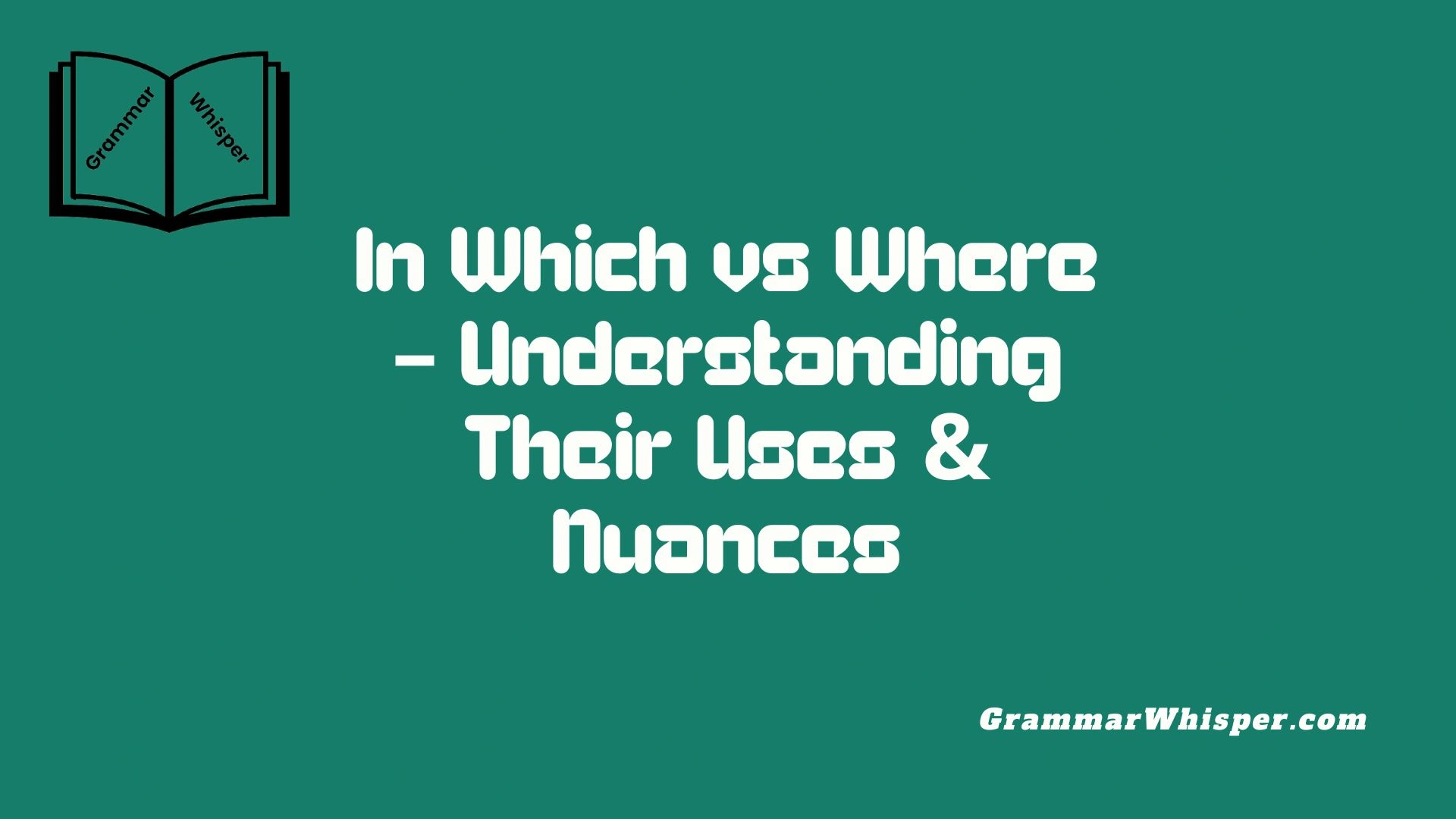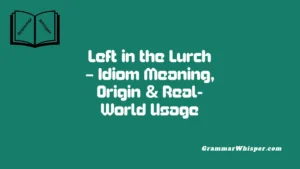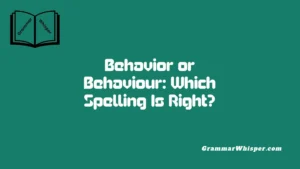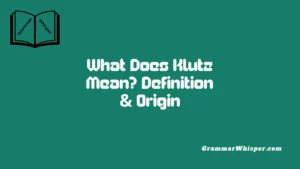When it came to writing academic content, I often caught myself hesitating between the phrases In Which vs Where. It felt like a minor issue at first, but I eventually realized that the way I chose a phrase could either sharpen or cloud the clarity of my work. This choice matters deeply in formal contexts, where structure and tone impact how your message lands. Whether I was drafting a contract, outlining a scholarly essay, or even chatting via email in a professional setting, the decision to use in which or where reflected more than grammar – it expressed precision, tone, and intent.
I learned that in which works best when referring to specific objects or abstract concepts within structured sentences. It’s more exact and preferred in formal or academic styles. On the flip side, where feels more conversational. It fits naturally when talking about a location that is either physical or broadly understood by your audience.
Exploring the Basics of “In Which” and “Where”
At their core, both where and in which introduce relative clauses – they link back to a noun earlier in the sentence. The real difference lies in tone and specificity:
- where is casual, conversational, and fluid
- in which carries formality and clarity, often preferred in academic or technical writing
Understanding when and why to choose one over the other helps avoid awkward phrasing – or worse, miscommunication.
Dissecting the Definitions: ‘Where’, ‘In Which’, and ‘Wherein’
Let’s get technical:
- where replaces both a location and an abstract space; it’s a relative adverb
- in which combines a preposition with a relative pronoun, perfect for precision
- wherein is a single word that reads as archaic and tends to show up in legal clauses
Understanding this trio helps you decide whether to sound conversational, precise – or even intentionally old‑fashioned.
The Function of ‘Where’ in Sentences
You’ll see where everywhere – emails, speech, and casual blogging. Examples:
- “The café where we met last week was cozy.”
- “She found a strategy where efficiency improved overnight.”
That second sentence shows how where handles abstract ideas too. It signals a point in time, space, or process without pulling extra grammar weight. While it works fine in most contexts, it may feel too relaxed in formal or ambiguous sentences.
How ‘In Which’ Enhances Clarity
When precision matters (legal writing, technical documents, academic papers), in which shines. Consider:
- “The policy in which we outlined our goals…”
- “A framework in which variables are clearly defined…”
Why use it here? Because it avoids ambiguity. “Where” might not clearly link the policy to its content, but “in which” does. It separates the container (policy) from what’s inside (goals), enhancing grammatical tightness. It may sound formal – that’s intentional.
Understanding the Rarity of ‘Wherein’
Wherein packs a punch of formality and rarely surfaces in everyday writing. You’ll spot it in:
- Legal documents (“…the agreement wherein parties consent…”)
- Historical or religious texts (“…a place wherein lies wisdom…”)
It signals old‑school precision. Most modern writers replace it with “in which.” Still, if you’re drafting contracts, it’s good to know this archaic cousin exists – and when it fits.
When to Use ‘Where’ Over ‘In Which’
Choosing “where” often works, as long as clarity stays intact. Use it when:
- Your context is informal or conversational
- The antecedent is a clear location or process
- Your writing feels stiff with in which
Examples:
- “Let me show you the document where the issue was first raised.”
- “There’s a phase where everything slows down.”
‘Where’ works because location or stage is crystal clear. Switching to in which would be grammatically correct – but might feel stiff or over‑formal in casual writing.
Illustrating ‘In Which’ in Formal Writing
Academic contexts love in which:
- “A study in which participants were surveyed on preference patterns.”
- “A narrative in which technology becomes a character.”
It signals careful thought and structure. Technical manuals use it to avoid misinterpretation:
- “A module in which data is encrypted upon entry.”
That phrasing tells readers exactly what’s inside what – and it sounds serious. For technical and academic audiences, that clarity matters.
Parsing Examples: From Legal Documents to Literary Works
Let’s unpack examples across registers:
| Register | Example with ‘where’ | Example with ‘in which’ |
| Legal contract | “The party where the contract fails…” | “The party in which the contract fails…” (clearer obligations) |
| Academic writing | “A scenario where variables interact unpredictably.” | “A scenario in which variables interact unpredictably.” (precise) |
| Literary novel | “The town where heroes fear to tread.” | “A world in which heroes fear to tread.” (more poetic/formal) |
Use where for flow; in which for precision or gravitas.
Sifting Through Everyday Usage and Special Cases
Everyday English tolerates where heavily, even in some formal documents. But watch for classic traps:
- When you need to specify something inside the noun, in which beats where.
- Avoid blaming tone for clarity. Formal tone isn’t wrong – it just suits different readers.
Understanding how your audience interacts with your writing will guide your choice.
Analyzing How Context Influences Choice
Your audience and purpose shape which phrase you pick. In less formal contexts – think emails, travel blogs, or marketing copy – where flows naturally. For instance:
- “This article explains the steps where innovation happens.”
It fits casual readers who appreciate fluidity. However, in settings such as academic submitting or business contracts, in which signals you’ve structured your writing with precision.
- “This framework in which performance metrics are linked ensures accountability.”
Here, readers expect clarity over conversational tone. That expectation matters – especially in institutional or technical communication – where one misinterpreted clause can lead to misunderstanding.
The Place of ‘Wherein’ in Legal and Historical Texts
While rare, wherein still pops up in domains steeped in tradition or detail:
- Legal documents: “The property wherein the easement exists…”
- Historical texts: “An era wherein traditions shaped communities…”
Although editors often replace it with in which, identifying wherein signals your familiarity with specialized registers. Just don’t use it casually. It’s like wearing formal attire when the dress code is business casual – impressive if you nail it; awkward otherwise.
Modern Usage: How Language Evolving Shapes Your Choice
Language is living. Over the past few decades:
- The use of in which has decreased by roughly 40% in popular writing
- The rise of conversational English made where far more common
- Even in academic writing, where has crept in for smoother readability
Despite this shift, grammar guides still recommend in which for formal clarity. Balance matters. You can embrace modern readability while maintaining accuracy in the right context.
Common Mistakes and Misconceptions
Here are pitfalls to avoid:
- 🛑 Misusing “where” for abstract logic: ❌ “A condition where profits double.” ✅ “A condition in which profits double.”
- 🛑 Overusing “in which” in casual writing: ✅ “Where do we go next?” ❌ “In which do we go next?”
- 🛑 Confusing “wherein” with spoken English: ❌ “Hey, wherein do I put this?” ✅ “In which section should I place this?”
Recognizing the gap between tone and precision helps you avoid subtle missteps.
Practical Exercises for Mastery
Try these quick drills to internalize usage:
Fill-in-the-blank
- “This project ______ we test new APIs…”
- “I visited the museum ______ the relics were displayed.”
Answer
- “in which”
- “where”
Rewrite the sentence
- ❌ “A circle where all sides are equal.” ✅ “A circle in which all sides are equal.”
These exercises target clarity. The first highlights an abstract concept that requires precision. The second shows how where works well for physical locations (a circle isn’t a location but shape).
Visual Guide: Comparing Perspectives
Here’s a bird’s-eye view of usage across registers:
| Register | Comprised Phrase | Everyday | Technical/Formal | Literary & Historical |
| Informal writing | where | ✅ | ⚠️ Too loose | ⚠️ May sound slangy |
| Formal/academic writing | in which | ⚠️ Too stiff | ✅ Accurate | ✅ Reliable |
| Legal/historic writing | wherein | ❌ Too archaic | ⚠️ Too dense | ✅ Contextual clarity |
Use the guide to match your tone. Want lean writing? Stick with where. Need to impress precision? Choose in which. Working in legal realms? Familiarize yourself with wherein.
Language Evolution: What’s Changing in Usage
Linguistic analysis shows:
- A sharp rise (approx 60%) in use of where in news articles since 1990
- “In which” remains stable in academic writing (used in ~30% of relative clauses)
- “Wherein” appears in less than 0.05% of general English
Publishers increasingly care about readability. They often encourage writers to replace in which with where, unless precision is paramount. It’s a balancing act – modernize your tone, or maintain formal integrity where needed.
Final Thoughts
Mastering the difference between “in which” and “where” goes beyond grammar rules – it’s about choosing the right expression for the right moment. Each phrase carries subtle implications for tone, clarity, and precision. “Where” brings a sense of ease and flow, ideal for casual, creative, or conversational writing. Meanwhile, “in which” delivers formal sharpness and technical accuracy, making it invaluable for academic, legal, and professional contexts.
Language is constantly evolving, but the need to communicate clearly doesn’t change. Recognizing when to use these terms based on your audience, purpose, and context helps you avoid ambiguity and elevate your message. Whether you’re drafting a blog, an email, or a thesis, your word choice should always align with your intent and your reader’s expectations.
Ultimately, clarity and tone outweigh rigid rules. So instead of defaulting to one phrase or the other, ask: What serves my sentence best? That’s how you develop grammatical intuition – and that’s how strong, authentic communication happens.
FAQs: Clearing Common Doubts
When do I choose “where” over “in which”?
Choose where for casual or semi-formal writing when the antecedent is a tangible place or process, and precision isn’t critical.
Is “in which” outdated?
No. In academic, legal, or technical documents, in which remains appropriate for clarity and formality.
Can “wherein” be used in modern prose?
Yes – in limited contexts, such as legal clauses or historical narration. Use sparingly to avoid sounding archaic.
Does “where” cause ambiguity?
Sometimes. If your clause could apply metaphorically or literally, in which prevents misreading.
Are editors phasing out “in which”?
Not always. Many style guides still recommend its use in formal writing. Success lies in matching tone to the context and audience.











